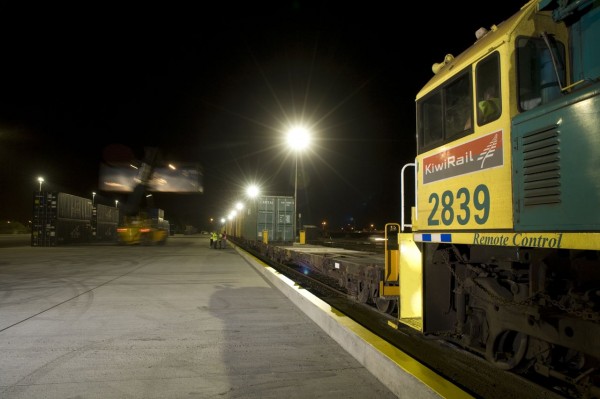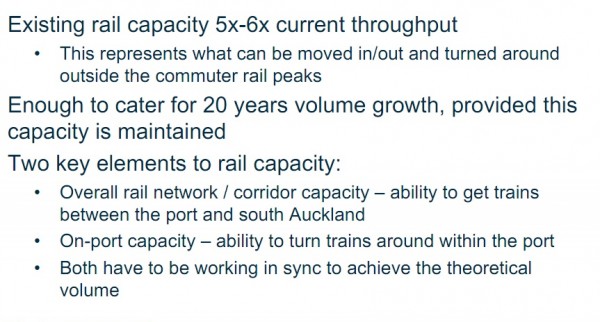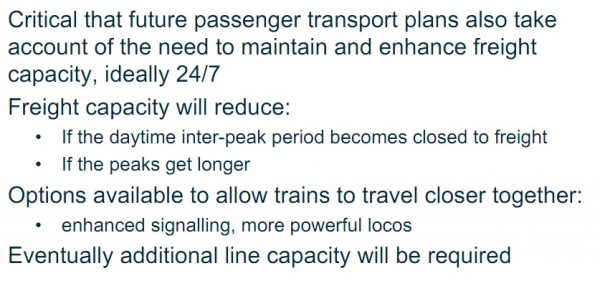Third Track Investigation
KiwiRail is being formally asked to investigate a third track for route protection on the North Island Main Trunk Line between Westfield and Papakura, and on the Eastern Rail Line.
This comes from the Auckland Council Transport Committee following a presentation from the Ports of Auckland.
A report from the Auckland Council’s Transport Planner says that over the longer term the development of the rail connection to inland freight hubs could encourage increased use of rail for inter-regional movements.
“Currently the rail system also provides sufficient capacity to accommodate freight movements from the Port to Wiri and commuter services on the Manukau branch for the foreseeable future.
“There is existing capacity for increased freight movements between the Port and Wiri during off-peak times with the current track set up that does not conflict with commuter services.”
He notes though that additional rail freight movements during the day were likely to create conflicts with existing commuter traffic so an “appropriate balance between the needs of these groups needs to be achieved, recognising the constraints of timing and routing under which the freight sector often operates.”
He says this problem is particularly prevalent for the section between Westfield and Wiri after the Manukau line is opened to the passenger service in 2012. The issue is particularly relevant near the Wiri Junction where a significant number of freight trains encounter the metro trains during the daytime.
KiwiRail has identified a number of operational and network infrastructure issues that need to be addressed in order to realise the full potential of rail freight services.
Potential improvements include:
- Suitable rolling stock which can carry heavier rated containers and loads on rail
- A third track on the NIMT Line between Westfield and Papakura and a third track on the Eastern Rail Line, to enable more efficient rail freight movements between the Port of Auckland and inland freight hubs and movements to the south
- Timetabling changes and new signalling
- Additional cross-overs that will provide for a southern access to the Port of Auckland.
With proposed increases in frequency of passenger rail services along the NIMT Line and the Eastern Rail Line, it is expected that there may be difficulty in also securing slots for rail freight (particularly if demand increases or movements are required during peak periods).
The report says KiwiRail has identified capacity issues on the section from Westfield to Papakura as a priority and its investigations to develop a solution are well advanced. KiwiRail has also identified that a third main or other capacity enhancements along the Eastern Rail Line may be required in the longer term.
“While no work is planned at this stage, KiwiRail is seeking to protect any possible capacity
expansion on parts of this route (for example at Orakei station and Sylvia Park station) by
ensuring adequate clearances in areas of new development and where bridges are being modified for electrification clearances.”
On that Eastern section there are two significant network impediments to a third track:
- The causeway across Whakatakataka Bay and Orakei Basin
- The Purewa tunnel
The Council Committee decided that any investigation of protecting a route for a third track on part of the NIMT Line between Westfield and Papakura should also include investigation of protecting a third track along the Eastern Rail Line.
As part of the development of the City Centre Masterplan, discussions have taken place with NgatiWhatua about its plans for development of the Quay Park area, and with POAL about its plans for increased freight movements.
The Council report says that these identified the need for a joint investigation between NZTA Auckland Transport, Auckland Council and Waterfront Auckland, of solutions to truck access along Stanley Street and to the Port of Auckland.
“Previous concepts of Stage 3 and 4 of the Grafton Gully State Highway project have not progressed and a fresh approach is required. An investigation into improved truck access along Stanley Street and to the Port of Auckland needs to consider future volumes of truck movements, potential development at Quay Park and a change in emphasis of Quay Street. “The investigation may cover traffic management solutions (such as signaling, timing of truck movements, back filling, etc), grade separation, and greater movements by rail to freight hubs.
“The draft Auckland Plan provides a good platform for Council to gain feedback on critical infrastructure for the next 30 years. The Port of Auckland is likely to be identified as critical infrastructure reflecting its crucial role in the efficient functioning of both the regional and national supply chains and economies. Transport links to serve the port functions may also be identified as critical infrastructure because efficient freight movement to and from the ports is vital to the economic performance of Auckland, the Upper North Island and New Zealand.”
POAL had identified in its submission on “Auckland Unleashed”:
“Approximately 87% of container movements to and from the Port of Auckland are by road, with 13% by rail. It is expected that the proportion moved by rail will continue to increase over time, perhaps reaching 30% or more in the longer term. However, ongoing volume growth means that road movements will continue to increase, and an efficient road network will remain critical to the ongoing operation of the Port.”
The relative roles and growth in container movements in relation to the Port of Auckland is shown in the graph below:
Rail passenger and rail freight flows, as they both grow, are likely to come into conflict and an appropriate balance needs to be delivered by KiwiRail as network manager, recognising the constraints of timing and routing under which both sectors often operate.
The following maps indicate the change in distribution patterns of freight from and to the Port of Auckland between 2004 and 2009. These show a high concentration of freight movement in the south:
The report to the transport committee says that these patterns may have been affected by the opening of the rail connection with the Wiri Freight Hub in 2010, with volumes through the Wiri facility less than 10% of total port container volume.
Large volumes of freight movement will occur on the roading network for trips between the ports and inland freight hubs, inter-regional movements and movements to/from industrial areas and distribution centres within Auckland.
The growth in imports and exports and the use of larger vessels is likely to result in an increased use of inland freight hubs, with consequential increases in local truck movements around those hubs.
“For example, there are no immediate plans to open any further inland ports within metropolitan Auckland. This may occur in the longer term if commercially viable and consideration has been given to a possible rail served inland port in the northwest sector around Kumeu.
“However, it is also possible that inland port developments following Wiri may be based outside Auckland, such as at Te Rapa in the Waikato. For these hubs to act successfully as holding areas, particularly for cargo to be exported on particular sailings, there must be confidence that the transport network can provide a high level of reliability.
“This reliability is required in relation to the rail network and road network, within Auckland and inter-regionally to the north and south.Since the operation of the rail exchange siding adjacent to the Wiri Inland Port in 2010, there has been a significant increase in cargo transferred from the Port of Auckland to the Wiri Freight Hubby rail for processing.”
Rail volumes currently represent 13.4% of Ports of Auckland’s total landside moves.
With the introduction of the rail connection at Wiri, and other initiatives to promote rail uptake, POAL, in its Auckland Unleashed document, envisages the proportion will increase, perhaps to 30% in the long term.
The Upper North Island Freight Study 2010 estimated that the Wiri Freight Hub will be able to carry up to the equivalent of 100,000 truck movements per year, which would increase the movement of freight by rail by about 1 million tonnes per year.
Slides below from the Ports of Auckland presentation to Council:














11 Comments
And of course KiwiRail have just rebuilt several overbridges with space for only the two existing tracks. Along with the stuffing up of Newmarket Junction and the Wiri triangle, it just goes to show how out of touch KR’s Wellington based planners are with the requirements of the Auckland region.
We have known for a long time that a third track will be needed to Papakura, but KR just couldn’t (and still can’t) see that vision.
Also, at Orakei, where four tracks will eventually be needed, KR are planning for three. They are basically setting us up for greater and greater additional costs in future.
Rail network planning in Auckland needs to be handed over to AT.
Geoff, we don’t need to be completely negative about this. This is a step forward to better Rail in Auckland, and New Zealand. Maybe they might be able to use the third rail for intercity rail services aswell. Only problem then is that people from Onehunga and the west will then need to get into the city, or in Onehunga’s case, transfer twice to get onto the intercity train.
I disagree, KRN deserve to be pounced upon for the way they are planning Auckland’s network. They are costing ratepayers big bucks by intentionally and knowlingly carrying out projects that are inconsistent with future requirements. AT is struggling to pay the track charges imposed by KRN, so we need to ensure that building things that need to ripped out again five years later doesn’t happen.
Geoff - Valid points. The amounts of rework and capital waste by KR is a disgrace especially when we all know how scarce capital is for Rail. Interim solutions, signaling reworks and contractors milking it due to commercial ineptitude by KR is legendary. The rework of DART section projects that were not electrification compliant is classic wastage. Some of this though is not KR’s fault and deferred decisions by funders have often meant a piecemeal approach to investment as things are approved for funding. The ones to gain from this are Contractors milking a bloated public entity for all it’s worth. Shame about the longer suffering taxpayers, ratepayers and rail customers.
However this is good news that is now getting some traction at long last so let’s be grateful for small mercies!
KR’s entire approach to Auckland rail needs to be rethought, starting with regular steering meetings with AT so that their plans are coordinated.
On the potential fourth rail, don’t forget that KR is still “owned” by a man who considers that trucks are the only way to move freight and cars are the only way to move people, so why would you bother planning for what would have to be very significant growth in both? The attitude from the top feeds all the way down when it comes to this kind of thinking.
Wont this be essential if AT is to have the proposed ten minute frequencies on the eastern and five minute on parts of the southern? That’s what the currently underway electrification proposal results in, so why are they even debating this?
Surely the approach would be to plan for a third and fourth track, but perhaps build only the third in parts to begin with. The bit that most concerns me is the Orakei development, they really need to designate a four track corridor there before the developer locks in their basment carparking and builds out the site.
Purewa cemetery is in Meadowbank.
Jon - this post has numerous images that don’t show up on my (Firefox) browser?
“KR’s entire approach to Auckland rail needs to be rethought, starting with regular steering meetings with AT so that their plans are coordinated.”
Well, there were submissions in the establishment process of the Super City that KiwiRail should have a non-voting board member in AT, like NZTA does. They were, of course, ignored by National.
Getting back to the matter at hand, and complaints about KiwiRail aside, this is a good development. Don’t let this be ANOTHER of these “doom and gloom” comment threads. Whatever happened yesterday or the year before, the fact that Auckland Council is thinking ahead is great news!
@Karl Yes thanks. A few things dropped off when the site was being moved to a new host. I will add it to my to do list.
Did KR build for only 2 tracks because they are stupid, or because the funder (AT or central government) would only pay for what their project required? Or a bit of both?
Bryan - not sure whether you are talking of WAY BACK when the lines where originally built, or of the current bridge upgrades?
Well, if you read through historical papers, you will find that in times past, the same discussions we are now having regarding whether one should (have) build a 2 or a 3-track line where once had over whether one should have a 1 or a 2-track line! So if they had said “let’s do a 3-track line” they would have been ignored as idiots. After all, Auckland then barely had a 100,000 people ALL over the region.
As for the current works - well, I expect a third track on a bridge costs anything like 25 to 50% more than just doing a new 2-track bridge. So with KiwiRail really hurting for money, and the government unlikely to stump up for some extra just to futureproof a doomed transport technology (their secret opinion of rail, in my opinion)…
So I suspect KiwiRail did look at triple-track bridges, but decided against it, because they couldn’t get them funded.